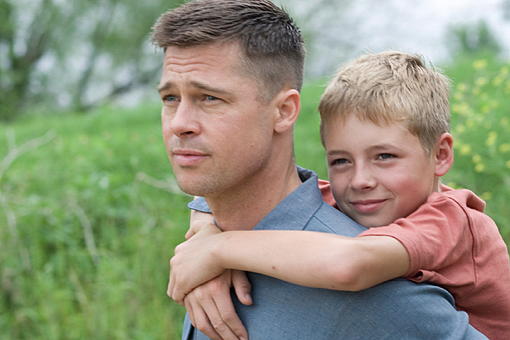By Ryan Mason · June 13, 2011

Certain movies require more of the viewer than others. Even the best summer blockbuster that hits all of the right notes to tug at our heartstrings and wow us with edge-of-your-seat action spectacle merely uses us as pawns, instructing us how to feel and when to feel it. And some people might mistakenly walk into The Tree of Life with those expectations; it was released in the beginning of June (which is definitively summer now that “summer” begins in April as far as Hollywood goes) and does star Brad Pitt and Sean Penn, after all. I’m sure there were at least four people who did that in the screening I went to because they were the ones who walked out after about 25 minutes. It’s too bad, too, because had they stuck around and been an active participant rather than a passive viewer, they could’ve had a thought-provoking, unique cinematic experience courtesy of the one and only, writer/director Terrence Malick.
To dissect The Tree of Life like a traditional Hollywood feature film isn’t a worthwhile exercise, so I won’t bother with it here. For a movie that has barely a page worth of dialogue in the first half-hour, it’s better to look at this as a two-part experimental film: one, a silent film examination of montage theory; and two, a coming-of-age tale about an adolescent boy’s relationship with his younger brother and their domineering father (Pitt). Interestingly enough, while the two seem quite different from each other, thematically they work in ways that truly stretch the cinematic tools to the max, utilizing the unique film medium to juxtapose images together to create emotion in ways that would make Eisenstein proud.
Admittedly, though, it took some time and energy to get into Malick’s fifth feature. We get so used to those elements of a typical narrative film that when those beats don’t hit when we expect them to, we get uncomfortable, antsy, even confused. Even those viewers who don’t spend all their free time studying film structure will at least be able to feel that something doesn’t seem right even if they can’t quite articulate why. What are we watching? Why are we watching it? What’s this movie about? And yet, all those questions are answered if you pay attention and let the film breathe like a fine wine rather than guzzle it down as quickly as you can like a light beer. Don’t get me wrong, there’s a time and place for both; you just need to be aware of the occasion so that you don’t imbibe the wrong spirit when you think you’re having the other.
The struggle in the beginning, and again later in the film, is the editing and its overall pacing. Most films don’t start out with a first act that’s comprised of a long montage with barely any dialogue outside of some voiceover narration. And not Shawshank-type narration that tells a story, rather it’s more like we’re hearing the occasional, fragmented thoughts of someone recalling old memories, both as emotion and as actual events. While there were moments during this section that I felt myself aching for a straightforward, narrative scene with characters interacting through dialogue, I was never bored. And as the film progresses into the middle section which has those types of scenes, you realize how much richer they are for having seen the all the preceding images.
And let’s talk about those preceding images: nothing I can say here can truly describe what you will see on the screen. Nor should I be able to because the last thing I’d want to do would be to ruin it. But that’s the thing: it’s so explicitly cinematic that it’s not something that the written word can express. Suffice to say that Malick and his team of visual artists have created one of the most unique visual expressions of the beginning of time ever captured on celluloid. And while you’re wowed by the raw visuals at the moment, the true joy comes long after the film is over and the thematic cohesion with those images coupled with the rich characters from the 1950s sticks in your mind on your way home and the day after.
The key to enjoying The Tree of Life comes from expectations. While Malick gives us a barrage of images, which in another movie might normally satisfy the average ADD filmgoer, there’s an immediately recognizable difference between the quick edits and the images here than in some other popcorn fare like Transformers. And it’s not the substance of those images – The Tree of Life has its surprisingly fair share of CG worlds, landscapes, and creatures – rather the meaning created by their juxtaposition. Instead of cutting from shot to shot after only a few frames in order to stun the viewer into thinking so much incredible action is happening despite not being able to discern quite what was going on, Malick’s edits exist to create meaning in true montage theory style. It’s not just the sheer number of different images that elicit the feelings; instead, it’s the reason behind those images being placed next to each other that creates the meaning.
It’s not normal to have your summer releases challenge you as a filmgoer. And if you’re not expecting it, you might find yourself completely unprepared for this type of experience. But if you’re willing to participate, The Tree of Life could end up being one of the more rewarding times you’ll spend in the theater this year.